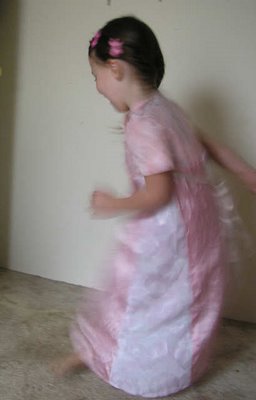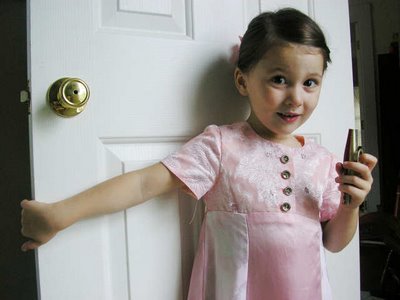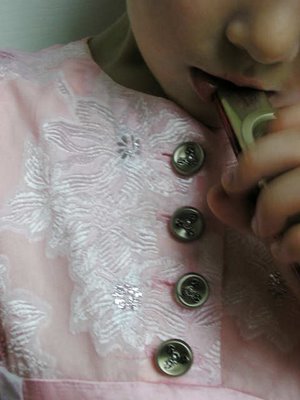A completely and Utterly Useless Rant
And I do mean rant. You have been warned.
So there was this article in the Wall Street Journal a few weeks ago (September 11, 2006, The Marketplace section; the article was written by Ben Winograd and Cheryl Lu-Lien Tan) that incensed me to no end. The article was titled "Can Fashion Be Copyrighted?"
This is the part where you imagine me with fireworks coming out of my ears.
The article says:
That, to me, seems a little too narrow. There are so many different ways to spring-board off of this, one hardly knows where to start. If one really wanted to get to the central issue, I suppose one would say the question is if anything can truly be copyrighted. Is anything really totally new? Isn't everything influenced, referenced, or copied in part from something else?
But, if we accept them at their premise, that the question is whether fashion design is art or craft, one would still think that the article ought to be about defining what makes art. Is the goal of art to make money? Can art really be copied, or does all art carry part of the artist? What makes art important?
Instead, everyone is arguing over whether or not knockoffs actually help the fashion industry (how can you possibly call it both an industry and an art?!). The idea is that if knockoffs actually help the industry, they should stay legal. But if it harms the "artist/industry/designers", then, de facto, it ought to be illegal. In other words, as far as most people are concerned, this is neither an ethical question, a question of art, or a question of protection. It's only a question of economics.
So how about the consumer? Aren't we being discriminated against if we're not allowed to buy a cheap knock-off? (And by knock-off, I mean a garment that looks similar, but doesn't claim to be the same, not someone pretending to be someone or something they're not.) Why should the high-end commercial artists be able to lock us into paying exorbitant prices? Isn't this what a free market is about? Open competition? These people are trying to get three years worth of protection for designs for everything from dresses to belts and eyeglasses. Why should the industries get the protection, and the consumers get abused? The proposed regulations "would cover the overall appearance of the item in question, barring even those made with inferior fabrics."
Some people do think that it's good to knock-off designs, and bring them within the price range of a mere mortal. The article says:
Well, no duh. And just because you are creating "original" designs doesn't mean you have to make people pay through the nose for them.
It's a well-known fact that those who are good at mass producing are rarely good at making "original creations", and that people who are good at creating are rarely good at mass production. Sometimes these two beings get together in a symbiotic relationship, with each helping the other in their weakness.
Usually, though, the one "creating" charges high prices, can't meet demand, or relies on a one-trick pony for all their business, wanting to lock it in as theirs and theirs alone. Then they throw a hissy fit when someone else finds a cheaper way of doing the same thing.
And I don't really buy into the whole idea that mass-producers are spared a lot of work--I'd bet that any company that knocks-off a design still has to order samples, make adjustments, source fabric, and get whatever patterns they need drafted. They only thing they're "stealing" is the design idea--which the "original" designer undoubtedly came up with after seeing something(s) similar, to begin with! So they have no excuse, because the very things they judge other people for doing they are guilty of doing themselves!
The only person in the article who seemed to have their head screwed on straight was a Mr. Valvo.
Exactly.
I think that mass producers will be mass producers, and it's stupid for those that aren't to pretend to be. If your strength really is your creativity, stop throwing hissy fits. You're only going to be able to be "original" with one design for so long, then, move on. Make something else original. Your strength lies in constantly changing and creating, not locking in the market. The mass producers will always be trailing behind you--you lead the way. If all you really care about is the design, you should be pleased with the integrity of your own design, and view the popularity of that design as witness to the quality of your work. And if all you are really worried about is making money, maybe you should quit being a designer--and make knock-offs instead.
So there was this article in the Wall Street Journal a few weeks ago (September 11, 2006, The Marketplace section; the article was written by Ben Winograd and Cheryl Lu-Lien Tan) that incensed me to no end. The article was titled "Can Fashion Be Copyrighted?"
This is the part where you imagine me with fireworks coming out of my ears.
The article says:
The central question is whether fashion design is an art worthy of protection or a craft whose practitioners can and should freely copy one another.
That, to me, seems a little too narrow. There are so many different ways to spring-board off of this, one hardly knows where to start. If one really wanted to get to the central issue, I suppose one would say the question is if anything can truly be copyrighted. Is anything really totally new? Isn't everything influenced, referenced, or copied in part from something else?
But, if we accept them at their premise, that the question is whether fashion design is art or craft, one would still think that the article ought to be about defining what makes art. Is the goal of art to make money? Can art really be copied, or does all art carry part of the artist? What makes art important?
Instead, everyone is arguing over whether or not knockoffs actually help the fashion industry (how can you possibly call it both an industry and an art?!). The idea is that if knockoffs actually help the industry, they should stay legal. But if it harms the "artist/industry/designers", then, de facto, it ought to be illegal. In other words, as far as most people are concerned, this is neither an ethical question, a question of art, or a question of protection. It's only a question of economics.
"If copying were illegal, the fashion cycle would occur very slowly, if at all," they write in an article to be published in the Virginia Law Review. While they concede copying can harm individual designers, they say Congress should protect industries only when piracy stymies--rather than encourages--innovation.
So how about the consumer? Aren't we being discriminated against if we're not allowed to buy a cheap knock-off? (And by knock-off, I mean a garment that looks similar, but doesn't claim to be the same, not someone pretending to be someone or something they're not.) Why should the high-end commercial artists be able to lock us into paying exorbitant prices? Isn't this what a free market is about? Open competition? These people are trying to get three years worth of protection for designs for everything from dresses to belts and eyeglasses. Why should the industries get the protection, and the consumers get abused? The proposed regulations "would cover the overall appearance of the item in question, barring even those made with inferior fabrics."
Some people do think that it's good to knock-off designs, and bring them within the price range of a mere mortal. The article says:
But fashion designers--who invest time and money drawing sketches, ordering samples and making adjustments--say such arguments ring hallow. Designer Catherine Maladrino. . .maintains that copying isn't the only way to bring fashion to the masses. "If you're creative, you can design original designs that are affordable," she says. "You don't have to knock off what other people are creating."
Well, no duh. And just because you are creating "original" designs doesn't mean you have to make people pay through the nose for them.
It's a well-known fact that those who are good at mass producing are rarely good at making "original creations", and that people who are good at creating are rarely good at mass production. Sometimes these two beings get together in a symbiotic relationship, with each helping the other in their weakness.
Usually, though, the one "creating" charges high prices, can't meet demand, or relies on a one-trick pony for all their business, wanting to lock it in as theirs and theirs alone. Then they throw a hissy fit when someone else finds a cheaper way of doing the same thing.
And I don't really buy into the whole idea that mass-producers are spared a lot of work--I'd bet that any company that knocks-off a design still has to order samples, make adjustments, source fabric, and get whatever patterns they need drafted. They only thing they're "stealing" is the design idea--which the "original" designer undoubtedly came up with after seeing something(s) similar, to begin with! So they have no excuse, because the very things they judge other people for doing they are guilty of doing themselves!
The only person in the article who seemed to have their head screwed on straight was a Mr. Valvo.
. . .Mr. Valvo says he's been copied so much he now shrugs it off when he sees styles that imitate his work. He finds the idea of legislation "insane". He says "Fashion is more evolutionary than revolutionary--you're always inspired by something else. Besides, I don't think anyone copying me would be able to do it in the same way."
Exactly.
I think that mass producers will be mass producers, and it's stupid for those that aren't to pretend to be. If your strength really is your creativity, stop throwing hissy fits. You're only going to be able to be "original" with one design for so long, then, move on. Make something else original. Your strength lies in constantly changing and creating, not locking in the market. The mass producers will always be trailing behind you--you lead the way. If all you really care about is the design, you should be pleased with the integrity of your own design, and view the popularity of that design as witness to the quality of your work. And if all you are really worried about is making money, maybe you should quit being a designer--and make knock-offs instead.





